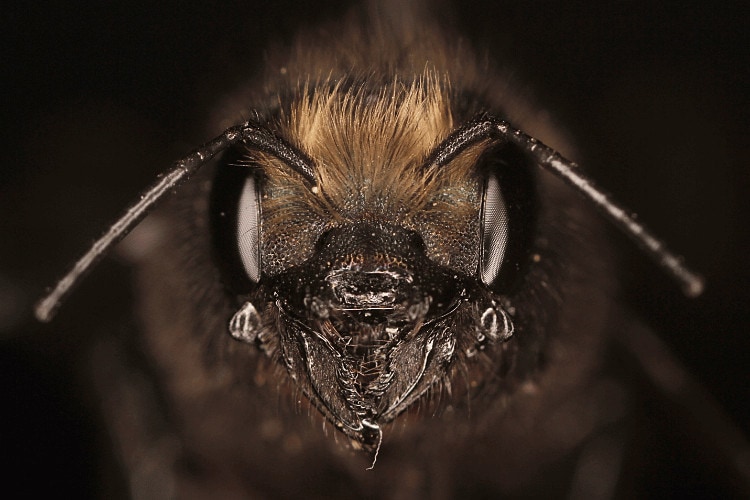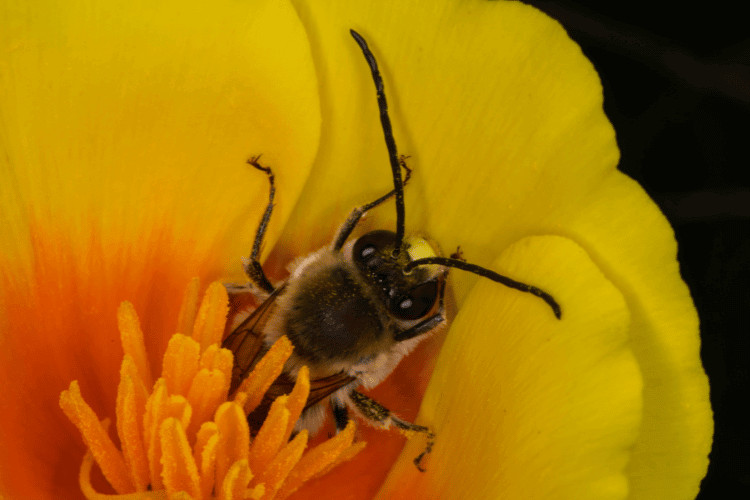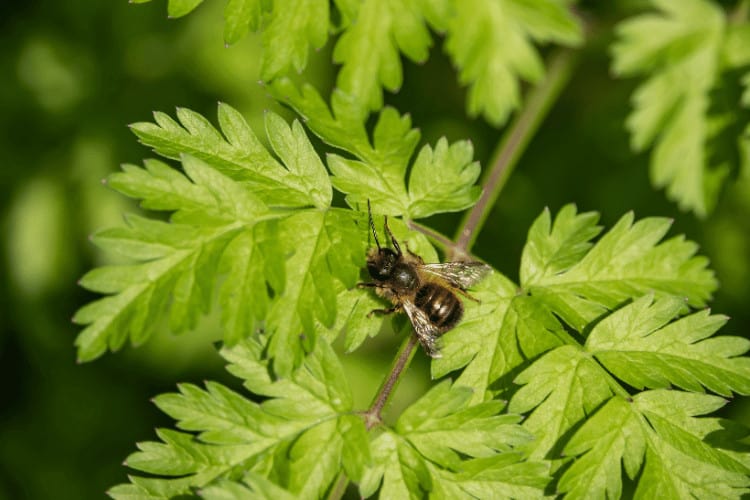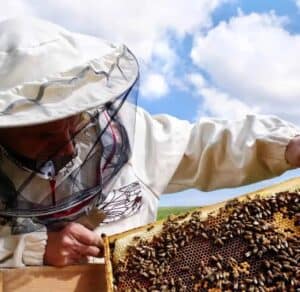Mason Bees 101: Your Ultimate Guide to These Pollinators
For beekeepers and nature enthusiasts alike, mason bees are like the unsung heroes of the pollinator world.
These pint-sized powerhouses, with their metallic-blue sheen and curious quirks, play an invaluable role in our ecosystem. Yet, what sets them apart from the average honeybee?
Well, if you’re looking to delve into the captivating world of mason bees and discover their little oddities, you’re in for a treat. Let’s embark on this bee-autiful journey together!
Description and Characteristics of Mason Bees

Mason bees, which hail from the genus Osmia, are excellent pollinators known for their distinct attributes that set them apart from other bee species.
If you’ve ever stumbled upon a bee with a shimmering, metallic tint on its skin and a bit of a tiny waist, you’ve likely spotted a mason bee!
These little wonders come in beautiful colors, from deep blacks to vibrant blues and even shades of green.
What’s fascinating about these bees is their diversity. While some resemble our familiar honeybees, others might have you mistaken them for a regular housefly.
Also, here’s a fun tidbit that earns them their name: these bees are natural masons! Any mason bee house is made using materials reminiscent of masonry to craft the chambers.
What is a Mason Bee’s Purpose
Mason bees are the silent heroes of the natural world, often overshadowed by the more familiar honey bees. Mainly, this is because they don’t produce honey.
However, if you’ve ever enjoyed a crisp apple or succulent berry, you might just have a mason bee to thank!
1. They’re Master Pollinators
At their core, mason bees are valuable pollinators. They’re exceptionally proficient in playing cupid for tree fruits like apples, cherries, and the wide berry varieties.
What’s even more impressive? TCome rain or shine, even on those cloudy, drizzly days that might deter other pollinators, mason bees are working out there!
2. Their Help Goes Beyond the Orchard
While their prowess in orchards is well-recognized, their positive impact doesn’t end there.
Mason bees extend their pollinating talents to a myriad of plants, contributing to the biodiversity and health of ecosystems across North America.
3. They’re Natural Pest Control
While their primary focus is on pollination, mason bees, like many other extraordinary pollinators, indirectly aid in controlling certain pests.
By supporting the health and reproduction of specific plants, they help maintain habitats for other insects and creatures that prey on common pests.
Mason Bee Habitat and Foraging Preferences
Mason bees are adaptable creatures when it comes to their habitat. Often, they select naturally occurring tubular cavities to establish their nests.
These could be in hollow twigs, old beetle burrows, or even the vacant nests of carpenter bees. Moreover, their flexibility doesn’t end there!
Sometimes, mason bees have been observed nesting in more unconventional places, such as snail shells or even under loosened bark.
While they appreciate a natural setting, these bees aren’t opposed to artificial nesting chambers. Some bees nest in cracks or holes in buildings or other structures.
As a result, providing them with artificial nesting aids, like wooden blocks with holes or cardboard tubes, can be a useful way to encourage their presence in gardens or orchards.
When it comes to foraging, mason bees have a penchant for fruit trees like apples, cherries, and pears.
Their early spring emergence aligns perfectly with the blossoming of these trees. Immediately after emergence, the females set out to forage on these trees, collecting nectar and pollen.
Unlike honeybees, which can venture far from their hive, mason bees tend to forage nearer their nesting spot.
Their approach to collecting pollen is thorough, almost meticulous; lacking pollen baskets, they roll in it, ensuring maximum collection on their fur.
Where Can You Find Mason Bees
Mason bees are versatile dwellers. They’ve got a knack for turning hollow twigs, abandoned beetle burrows, or even old snail shells into comfortable homes.

Their adaptability extends to geography too. These efficient pollinators thrive across North America, from urban centers to tranquil countryside.
However, venture into the colder parts of the far-north regions, like Canada and Alaska, and their presence diminishes. Their affinity for temperate zones makes them a common yet remarkable sight in diverse ecosystems.
The Mason Bee Life Cycle, Mating, and Nesting
Mason bees are remarkable creatures with distinct behaviors and nesting habits that set them apart from other bee species. Here’s what I could find out about them:
Their Life Cycle
The mason bee develops across four different stages. Those are:
1. Egg Stage
The life of a mason bee begins as an egg, meticulously laid by the female atop a mound of pollen inside a suitable cavity. This pollen provides essential nutrients for the upcoming stages.
2. Larvae
After some time, the egg hatches, revealing a hungry larva. This larva’s primary job is to eat voraciously on the pollen mound for about two to three weeks. As it grows, it goes through a couple of molting phases.
3. Pupae
After consuming all the pollen, the larva spins a cocoon around itself and enters the pupal stage. This is a transformative phase where the bee undergoes significant changes.
4. Adults
Males usually emerge before the females, eagerly waiting to mate once the females make their appearance. Female bees live for around one month and lay at least one egg daily.
As for the male bees, they only live for about two to three weeks as their purpose is to impregnate the females.
Mating Rituals
Female mason bees have a systematic approach when it’s time for reproduction. They prioritize placing female eggs deeper within the nest, reserving the front sections for males.
This ensures that male adult bees greet the world first come spring. These early risers hang around nectar-rich spring flowers, patiently awaiting the emergence of females.
Upon a female’s arrival, a swift mating dance ensues. Unlike honey bees, male mason bees can repeatedly mate without dying within 20 minutes!
Nesting
Post-mating, the female bee transitions into a dedicated homemaker. She scours the surroundings for ample pollen, her prime focus being to cater to her upcoming brood.
After accumulating a sufficient stash, she retreats to her mud-made nesting chamber, crafts a pollen mound, and places an egg on it.
Importance of Mason Bees in Ecosystems and Agriculture
Mason bees hold an esteemed position in ecosystems and agriculture, often leaving a mark that’s way more impactful than their size might suggest. For instance, they affect the following:
Ecosystems
- Biodiversity Boosters: Mason bees help enrich our ecosystems by pollinating diverse plant species. This ensures varied plant life, which in turn supports a plethora of wildlife.
- Food Chain Contributors: Beyond pollination, mason bees are a valuable food source for predators. Their presence helps sustain a balanced food chain, wherein each link is interconnected and equally significant.
Agriculture
- Crop Champions: Mason bees excel at pollinating various crops, especially tree fruits. Their efficiency often surpasses that of many other bee species, ensuring bountiful harvests for farmers.
- Weather Warriors: Unlike native pollinators who shy away from less-than-perfect weather, mason bees get down to business. This resilience ensures consistent pollination, irrespective of unpredictable weather patterns.
Common Questions About Mason Bees
Now that you know almost everything about mason bees, here are some of the most common questions I’ve seen:
What do Mason Bees eat?
Mason bees primarily feed on nectar from fruit tree blossoms, such as plums and cherries. As they forage, they inadvertently collect pollen, which they use to provision their nests.
Are Mason Bees dangerous?
No, these bees are peaceable and non-aggressive.
They usually don’t sting unless trapped or squeezed, and even then, their sting is far less painful than that of honeybees, as they don’t have venom.
What size are Mason Bees?
Mason bees vary in size but are typically between ⅜ to ⅝ inches long. Their compact size, often comparable to a housefly, combined with their metallic tint, distinguishes them.

How to Identify Mason Bees
Identifying mason bees can be simplified by observing the following characteristics:
- Metallic Tint: They often have a distinctive metallic sheen, ranging from blue to green.
- Tiny Size: Typically between ⅜ to ⅝ inches long, similar to a common housefly.
- Absence of Bright Stripes: While they have faint lines resembling stripes, they mostly lack the famous bright yellow or red patterns.
How to Attract Mason Bees
Attracting mason bees to your corner isn’t as hard as you might think, even if you’re a novice beekeeper looking to increase his bee population! Here’s how you can create a little haven for them:
Offer Suitable Nesting Sites
Mason bees don’t ming pre-made habitats. Consider setting up a bee house filled with hollow bamboo tubes or drilled blocks of untreated wood.
The ideal diameter of the holes should be between ¼ to ⅜ inch, around six feet above the ground, and three to six inches deep.
Mud Sources Are Essential
These bees get their name from their masonry-like behavior.
So, providing a patch of damp clayey soil near their nesting area is crucial, as female mason bees create mud partitions and seal their nesting tubes using mud.
3. Plant Various Blooms
Mason bees are primarily attracted to native flowers and fruit trees like apples and pears. Planting a wide selection of flowers ensures a steady nectar and pollen supply.
4. Avoid Pesticides
Like all pollinators, mason bees are susceptible to chemical pesticides. Using natural and organic pest solutions will keep these bees safe and encourage them to visit more frequently.
Quick Recap
Mason bees serve as effective pollinators for many tree fruits and berries, diligently working even under gray skies.
Adaptable in habitat, they nest in various nooks, from hollow stems to old snail shells. Spread across most of North America, they engage in unique mating rituals highlighting their intriguing lifecycle.
Their presence reminds us of the intricate and fascinating world of nature that often exists right under our noses.

Joseph Davis
My goal is to show that anyone can take up beekeeping and it can be a very rewarding hobby. I strive to share my experiences and answer any questions you may have.
